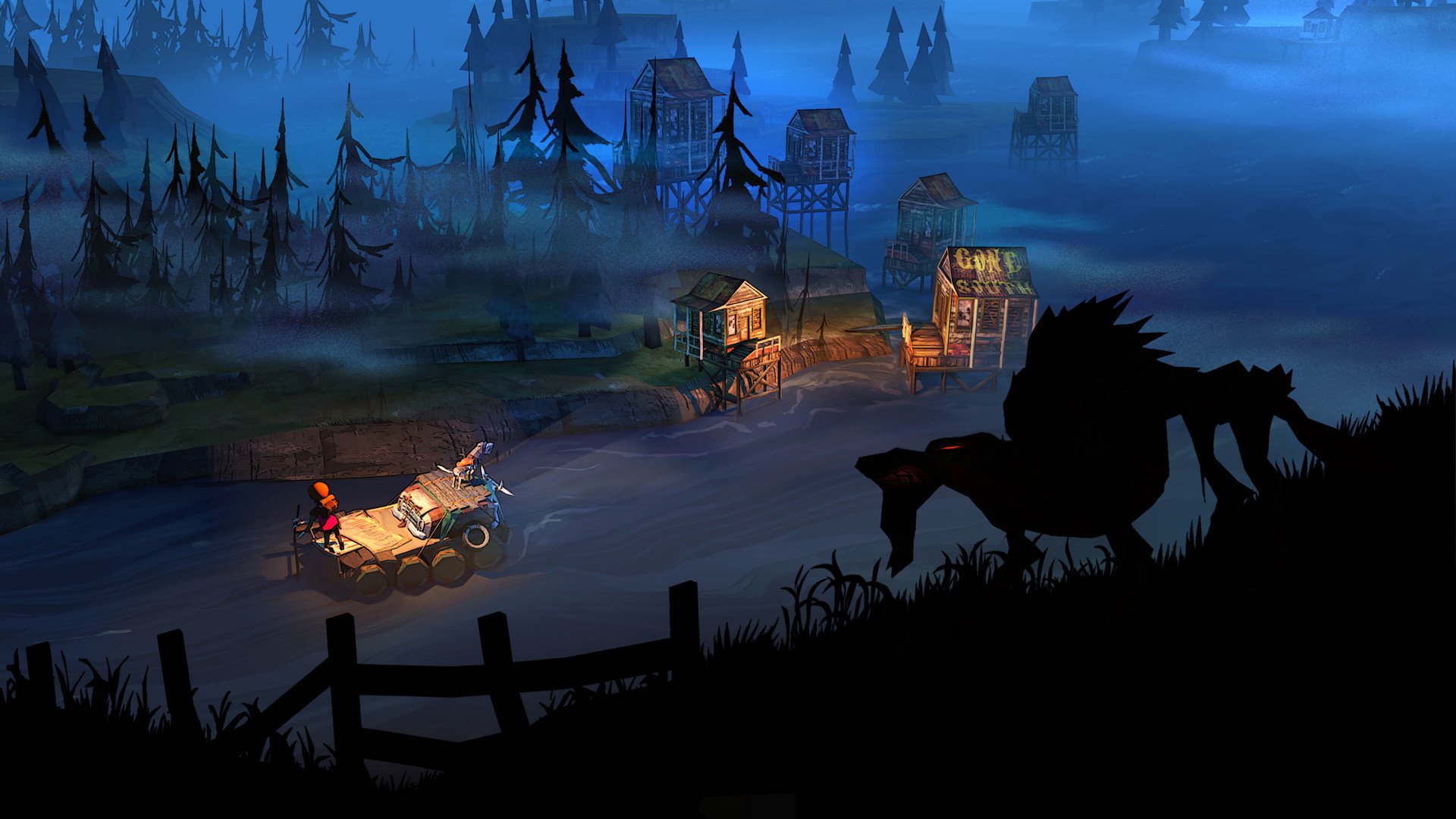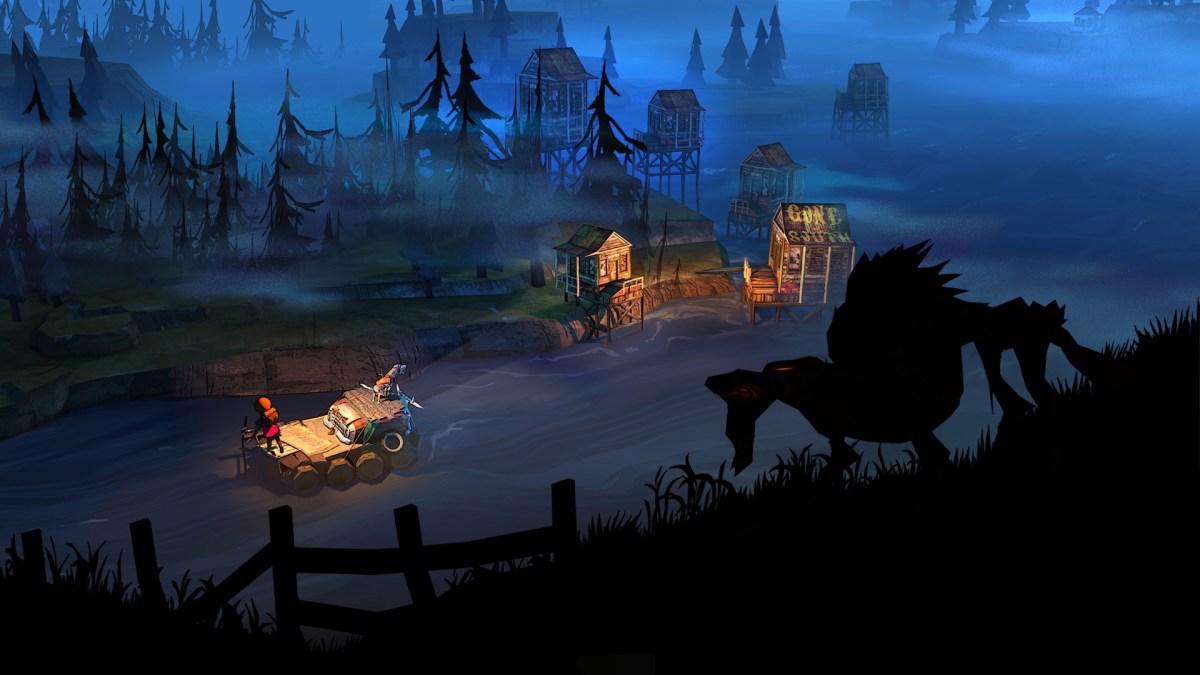Rollin’ on the river
Day 22. I’ve been drifting down this river for weeks now, and I’m starting to get desperate. That damn boar broke my arm, and I haven’t been able to scrounge up the supplies to make a proper splint. Since I couldn’t kill the boar, I have no food left, save for a handful of mulberries. They won’t hold me over for very long, I’m afraid. And to top it all off, the rain simply refuses to stop! I’ve been soaked to the bone for days, and the temperature keeps dropping. If I don’t find shelter soon, this might be the end for me.
Such is the life of Scout in The Flame in the Flood, the debut game from newly-formed studio The Molasses Flood. Surviving the deadly rapids and even deadlier wildlife will not be easy, but at least Scout has a faithful canine companion by her side. Now if only she could find a bit of food and some decent shelter…

The Flame in the Flood (Xbox One, PC [reviewed], Mac)
Developer: The Molasses Flood
Publisher: The Molasses Flood
Released: February 24, 2016
MSRP: $19.99
In a post-societal world where humanity is scarce and towns lay abandoned and falling into disrepair, Scout finds herself fighting for survival with only her dog, Aesop, to keep her company. An approaching cloud mass signals an impending flood, so Scout boards a raft and embarks on a journey down the river to safety.
To put it plainly, this is a survival game with crafting mechanics and randomly-generated locations. It’s a genre that has gained a lot of popularity in recent years, with many similar titles appearing all over the Steam marketplace. But The Flame in the Flood manages to inject some fresh ideas into the formula which help it to stand out. Primarily, it accomplishes this with its unique river setting.
Scout’s main goal is to travel down the river to a safe location, following a radio signal that promises sanctuary. This requires her to keep moving, which is the key element that differentiates The Flame in the Flood from similar titles, such as Don’t Starve, where the goal is usually to build a shelter for safety, then keep acquiring more supplies and building more things to live as long as possible. Here, staying in one place is not an option. At most, Scout can build a campfire to rest in one location for a day or so, exploring the area in order to gather as much food and supplies as can be found before she must leave.
Crafting is key to survival, but Scout won’t be crafting shelter. She will need to build basic tools, like knives and hammers, in order to make the other things she needs to stay alive. Other objects to craft generally fall into five main categories: food, medical supplies, clothing, animal traps, and raft upgrades.
But to make stuff, she first needs to gather supplies. Plants can be collected to use as food, medicine, or crafting material, animals can be hunted for food and clothing, and other random scraps from abandoned towns, buildings, and vehicles can be used for various purposes. Each location has a limited amount of supplies, though, so once it has been cleaned out, it’s time to move on to somewhere new down the river.
Of course, the river is not going to make things easy for Scout. It seems like everything is out to get her. Boars, snakes, wolves, and bears roam the wilderness just waiting to attack, inflicting bites, broken bones, and lacerations. Poison ivy and brambles can leave her cut up and itchy. The rain and cold can cause illness. If any of these ailments are left untreated, they might worsen and create further complications.
The most unfortunate thing about these medical emergencies is that they usually cause Scout’s other stats, like hunger or body temperature, to drop rapidly. It’s crucial to cure any ailment quickly, or else she might end up burning through a lot of her food stores to compensate for her sudden insatiable appetite. For this reason, players who are just starting out will want to be extremely careful around wild animals and other hazards until they can obtain sufficient medical supplies. In fact, whenever I found an area with wolves or boars, I almost always ran away immediately and hopped back on the raft to find another location, unless I had some traps ready to deploy. A broken bone or laceration with no way of curing it will almost certainly lead to a swift death.
It’s also important to be careful while navigating the river itself. Rocks, floating cars, and other debris can tear the raft apart and send Scout flying into the water. The raft is somewhat difficult to control at times; turning needs to be done well in advance of obstacles, but there is also an option to paddle quickly in any direction in an attempt to move to safety at the last second. Rapids make things even harder, nearly doubling the raft’s speed and making it much easier to careen into obstacles.
While on the river, upcoming docks will appear along the map with an icon indicating which type of area to expect. For example, marinas can be used to upgrade the raft, clinics contain plenty of medical supplies, camps always have a lit campfire, churches offer good shelter, and wilderness areas are often crawling with animals. It’s usually not possible to stop everywhere, since the river can make maneuvering to each dock difficult, so the icons can help the player plan out the best course of action to find what they need.

All of that survival stuff might sound tough, but one of the biggest difficulties actually comes from item management. Storage space is very limited. If Scout is near the dock, she can store more items on the raft for later. She can also give things to Aesop for safe keeping. Should Scout die, anything Aesop is holding will carry over into the next game, so I usually had him hold onto my most valuable possessions just in case. It’s also possible to craft a pouch to hold extra items, and increase the storage space on the raft as well. It’s a good idea to get those done as soon as possible to avoid wasting time sorting through items to decide what to hold onto, what to drop, and what to eat or craft in order to make room for more stuff.
This means a lot of time will be spent in menus, which brings me to one of the biggest problems I had with the game: time does not stop when the player opens the inventory menu. If the menu is opened when a wolf is in sight, the wolf will continue to attack even though Scout cannot move. It also means that Scout’s stats will continue to drop while the menu is open, so if she’s down to the wire and trying to craft something edible to stave off hunger, it’s possible she might die of starvation before the food can be created.
To further complicate matters, some items won’t stack automatically if the inventory is full, so if a player wants to stack the mulberries Scout is holding with the ones Aesop is holding, Aesop will need at least one blank space before the items can stack. This just leaves the player spending even more time fumbling around in the menus trying to rearrange everything perfectly, and with stats constantly dropping, that’s not a good use of Scout’s time.
The Flame in the Flood offers two different modes of play, each with the same basic gameplay components outlined above. Players can choose between Endless Mode, to see just how far they can make it down an endless river, or Campaign Mode, which features randomly-generated locations mixed with a few static, story-related locations scattered along a finite river.
In Campaign Mode, Scout has to navigate ten distinct sections of river before she reaches the end. This mode also contains NPCs, some of which appear in the story-related areas, while others can be found randomly. NPCs usually offer items to trade, or will sometimes give Scout an item for free. They might offer other things as well. In a world so desolate and lonely, it’s often a shock to find another human lurking around. Sometimes they’re a comfort, but other times they’re actually sort of creepy.

Campaign Mode also offers a checkpoint system, allowing Scout to continue her journey from a certain point if she dies. The checkpoints occur automatically and record everything that has happened up to that point, including inventory, stats, and ailments. Unfortunately, a checkpoint might occur at the most inconvenient moment of Scout’s journey, like when she’s already on the verge of death. In one of my games, I reached a checkpoint right when Scout got sepsis from an untreated wound, leaving me mere seconds before she died. I had to just start a new game from the beginning. The game compensates for this somewhat by allowing the player to choose from the last two checkpoints, but it still sucks to lose so much progress, especially if it happens at the very first checkpoint.
Aside from problems with the menus, item management, and possibly with the checkpoint system, I also ran into a few bugs and some general framerate hiccups. I had two instances where the game froze or crashed completely, and one instance where a sound effect got stuck on an infinite loop until it eventually caused a crash as well. Luckily, nothing caused me to lose any progress, but it was bothersome nonetheless.
Even with its flaws, The Flame in the Flood remains an engaging and challenging survival game. It may seem brutally difficult and maybe even a little unfair to beginners, but once the basic concepts of crafting, item management, and fending off wildlife are fully understood, surviving the harsh environment becomes much more feasible. Scout’s journey is definitely not impossible, and overcoming the punishing tribulations only serves to make her eventual victory all the more satisfying.
The post-societal visuals of crumbling buildings, broken-down cars drifting along the flooded river, and menacing wildlife lurking in the distance, paired with an excellent folk rock soundtrack featuring Chuck Ragan, creates a unique atmosphere of exploring a desolate frontier. It’s easy to become absorbed in this world and end up spending much more time on this treacherous river than you initially intended. That is, until it swiftly kills you without remorse. It seems mother nature is a cruel mistress indeed.
[This review is based on a retail build of the game provided by the publisher.]





